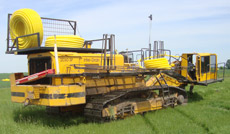
Drainage systems – then and now
History of drainage
The earliest reports of draining come from the Babylonians, who used clay pipes to remove water from burial mounds. The Romans recorded the draining of the Pontine Marshes. They accomplished this, however, with the use of stones and shrubbery.
In 1650 in England, drainage systems came about that were made of wood, fascines and stones (gravel). After that, people used roof tiles to drain and these were considered the precursors of the drainage pipes made from clay. The invention of presses for making clay drainage pipes brought about a rapid boom in drainage in Europe. Open draining was largely replaced by underground pipe systems.
Nevertheless, the basis for every drainage system – even today – is a system of artificially installed or natural outlet channels (open or closed) for conducting excess water via a system of trenches or ditches, for example.
Laser technology comes to drainage machines
After 1950, heavy duty drainage machines were used for installing pipes. Around 1960, the first drainage pipes made of plastic arrived on the market. By 1972, drainage ploughs were used that simply sliced open the ground, i.e. they worked without making ditches. These efficient methods ensured that depth control of the slope was precise. For this reason, machines today are controlled by a laser, so that the incline is optimally utilized. Laser technology makes this possible with even very gradual inclines.
The value of drainage today
Today, it is not possible to imagine agriculture without drainage. Drainage is the one method of improvement that results not only in increased productivity but also makes mechanized agriculture possible in the first place.
In northern Germany, there remain very few undrained fields, so mostly these drainage systems require just maintenance and repair, since they originated in the 1960s and 1970s. In the new German states, this kind of “improvements” often were from as early as 1910/20 – and in general these are clearly in need of replacement.
In the East and West, the question may be of replacement or repair: well-functioning drainage systems always give value for money, such as economic benefits and other advantages of drainage can show.
Services & Benefits

Planning Präziser Dränageplan mit Hilfe von GPS für eine exakte Positionsbestimmung. read more...

Increased yields Mit einer Dränung erreichen Sie Erstragssteigerungen bis zu 100%. read more...

Drainage installation Verlegung/ Installation von Drainagen auf landwirtschaftlichen Flächen. read more...


